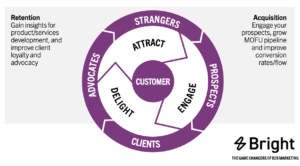Women in Crypto event takeaways:
Check out the event here
Last week I attended a great event with some fantastic speakers – Women in Crypto: How will the metaverse affect you? It got me thinking as a B2B marketer – there is a lot to unpack and explore to harness the opportunities Web3 presents. The event made clear that Web3 is a long-term strategy; spanning a 3 to 5-year time horizon and needs to be considered alongside other marketing channels and tactics. As the world becomes more immersive B2B marketers need to think about how they will complement Web2 experiences and how it can be used to build their brand and generate leads.
Lavinia D Osbourne founder of the Women in Blockchain talks brought blockchain to life by sharing a simple train metaphor – think of blockchain as the train tracks, the trains as the platform providers (such as Coinbase) and the train carriages as the assets such as NFTs and tokens. Lavinia focused on the opportunities for mass adoption to create a more diverse and inclusive web experience within the Metaverse.
Seema Khinda Johnson, founder and COO of Nuggets, a leading self-sovereign verified identity and payments platform, spoke about the potential for Web3 to level the playing field. One area that is ripe for change is KYC (know your customer). In Web2 you provide a lot of data to organisations who then control that data. With Web3, you own your data and can share it with organisations on a permission basis. This has massive implications for marketing as we know it today, where organisations have access to large amounts of data that they can use to target individuals, including selling it off to unknown buyers, and presents a huge risk if it falls into the wrong hands.
Kerry Elsdon, VP of Global Digital Marketing at Mastercard talked about three areas that we’ll see shifts in and marketers need to consider. Firstly, fun & social interactions will change hugely and we’re already seeing a shift in newer generations focusing on how they present and express themselves via avatars, wearables and NFTs. Secondly, the way we shop and why we shop – how shopping will become more immersive, interesting and accurate (yes! the demise of multi-buying and endless trips to the post office for returns!). Finally, shifts in how we learn and work as the Metaverse provide new immersive and interactive experiences.
A thought that I agreed with was that marketers should avoid feeling overwhelmed by the new environment by asking questions and not being afraid to seek assistance and advice; much is still developing, and you’ll get there sooner if you’re nimbler in your approach.
It was reassuring to hear some war stories from Camilla McFarland, VP & Head of Customer Success at Mojito, an NFT platform for brands entering Web3. Camilla shared how major brands such as Nike are taking a long-term 3 to 5-year view of their Web3 strategies and projects and are still very experimental.
Marketers have a huge opportunity with Web3 to become more inclusive and create truly engaging and immersive experiences that transcend geographic and economic boundaries. Now is the time for B2B marketers to get Web3 ready and take an agile approach to understand how they can offer a valuable and meaningful experience to clients, partners and employees. Start small, test, learn and improve to build out a strategy that works harmoniously with their Web2 presence and will allow users to direct how they want to engage in a Web3 world.
The event was informative (Bravo to Lauren Ingram from Women of Web3, Wirex and The Cryptonomist for a great real-life event). It was great to hear from some of the industry leaders about their thoughts on Web3 and the Metaverse. My biggest takeaway was the importance of being agile and taking a long-term view when developing a Web3 strategy. It’s also important to remember that we are still in the early stages of adoption and experimentation so it’s important to be open-minded and willing to learn. Web3 and the metaverse will provide new opportunities for B2B marketers to reach their target audiences through more engaging and interactive content whilst allowing more efficiently and accurate data collection.
What did you think of the event? What was your biggest takeaway? Let me know in the comments.













